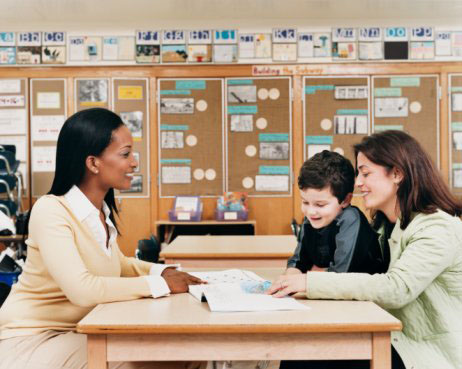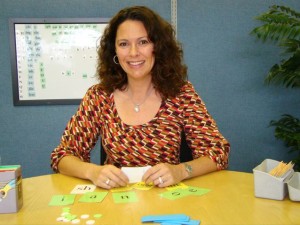
by PRIDE Reading Program Admin | Apr 10, 2016 | A PRIDE Post, Reading Comprehension
Many students with Learning Disabilities process information differently. They may be unaware of simple reading comprehension strategies that strong readers use automatically, such as rereading passages they do not understand.
Students with learning disabilities typically recall less about stories they have read and cannot easily identify the important information in them. Here are a few reading comprehension strategies that can be used either at home or in the classroom to help students with learning disabilities comprehend and understand text.
Retelling
Retelling is a frequently used process that involves asking students to recall and restate the events in a story after they have read it or heard it. Teachers or parents should first model the different parts of the story for the student. For example, starting a story by saying “once upon a time,” and then prompting the student to retell the story by asking:
- Who is the story about?
- Where does the story take place?
- What is the main character’s problem?
- How does the main character try to solve the problem?
- How does the story end?
Theme Scheme
The use of a theme scheme during explicit instruction in reading comprehension will help students transfer the strategies they learn to novel texts. The Theme Scheme includes the following steps:
- Introduction and pre-reading discussion: The teacher defines the concept of THEME and introduces the background of the specific story for that lesson.
- Reading the story: The teacher reads the story aloud, stopping to ask questions designed to encourage the student to process the theme.
- Discussion: The teacher and student discuss the following questions:
- Who is the main character?
- What is the main character’s problem?
- What did the main character do about the problem?
- What happened next?
- Was that good or bad?
- Why was it good or bad?
- The main character learner that her or she should _____________.
- Apply the theme to other story examples and to real life experiences: The teacher introduces another story that provides another instance of the same theme. The teacher and student discuss the example using the above 7 questions plus:
- When is it important to ________?
- In what situation is it easy/difficult to ________?
- Review: The teacher reviews the above questions and asks the student to think about other examples.
A follow up activity: The teacher leads a follow-up enrichment activity, such as writing, drawing, discussion, or role- playing.
Predicting
In this activity, the teacher reads a story to the student or has them read the story aloud. The teacher stops the reader before getting to the story’s resolution. Then the teacher asks the student to predict what comes next in the unfinished story. Another option is that the teacher can provide a list of possible endings from which the student can choose.
Cloze Activity
The teacher removes a portion of text from the middle of a story and then has students fill in the missing information. To optimize the benefits of this approach, it is valuable to discuss the types of information that would be anticipated. For example, the teacher might remove the description of the problem faced by the characters in the story. The teacher then could show the student a story map and then ask the student what aspect of the map is not obvious in the story. The student can brainstorm possible problems that would make sense, given the other information presented in the story.
The above strategies are designed to enhance reading comprehension and have been used to teach students with learning disabilities, with promising results. Students struggling with reading comprehension can achieve gains, including the ability to transfer what they have learned to novel texts, when they are given highly structured and explicit instruction in reading comprehension.
Learn more about the New PRIDE Reading Program
________________________________________________________________________
Karina Richland, M.A. is the Founder of PRIDE Learning Centers, located in Los Angeles and Orange County. Ms. Richland is a certified reading and learning disability specialist. Ms. Richland speaks frequently to parents, teachers, and professionals on learning differences, and writes for several journals and publications. You can visit the PRIDE Learning Center website at: www.pridelearningcenter.com

by PRIDE Reading Program Admin | Mar 21, 2016 | News & Events
Come to our Open House in San Diego to learn about our specialized reading, writing and comprehension camp in San Diego this summer.
Our summer reading camp at PRIDE Learning Center will run weekly from June – August to accommodate busy schedules and traveling families. Children can attend from either 9:00am – 12:00pm or 12:30pm – 3:30pm Monday – Friday. All teachers are credentialed and deliver one-on-one Orton-Gillingham language and reading lessons.
We will be in San Diego on Wednesday, April 13 from 3:00 – 6:00pm at the Chabad Center of University City, 3813 Governor Drive, San DIego, CA 92122. Join us to learn more about our program, meet our staff and register for our summer camp. We will also be offering reduced rate assessments if you would like to bring your child in for this special event.
Individuals interested in the Open House and Reduced Rate Assessments in San Diego can call (949) 484-0230 to RSVP or email info@pridelearningcenter.com.

by PRIDE Reading Program Admin | Mar 20, 2016 | A PRIDE Post, IEP
The single most important source of information on your child’s progress is the classroom teacher. The teacher talks with you after school, at the IEP meeting, and at consistently scheduled conferences. The teacher completes your child’s progress reports and corresponds back and forth with you. The teacher talks with the school psychologist, the physical therapist, the speech and language therapist, the resource specialists and administrators about your child’s needs and progress, and then the teacher communicates with you.
The abundance of information between you and the teacher will depend mainly upon your relationship with one another. If the teacher perceives you as a proactive parent who also understands the needs and problems of a teacher, and if you believe the teacher can teach your child effectively, you will probably receive plenty of up-to-date, specific information about your child’s progress. But how do you as a parent develop this cooperative relationship with your child’s teacher? You may wish to try some of the following suggestions:
- Try to develop a personal relationship with your child’s teacher. Let the teacher know that you are working together with them as a partner in educating your child.
- Give the teachers and specialists sufficient time to get to know your child before asking their opinions about your child’s progress, problems, the appropriateness of the program, and so forth.
- Let the teachers and specialists know you understand the difficulties they frequently face in doing their jobs – be empathetic to their needs, too!
- Prepare for conferences in advance by developing and bringing with you a list of questions, concerns, and comments. This saves everybody time and ensures that nothing important will be overlooked.
- Let teachers and specialists know what is important to you in the education and development of your child.
- Discuss and share your plan for monitoring your child’s IEP, and follow through with that plan.
- Discuss problems you believe have arisen in implementing the IEP with the teachers and specialists involved. Don’t begin by going right to the school administrators.
- Consider ways you might volunteer time or materials for the classroom.
As these relationships are developed and strengthened, you will experience more and more confidence in your ability to know and understand your child’s progress and the extent to which her IEP is actually being implemented.
_________________________________________________________________________________________________________
Karina Richland, M.A. is the Founder and Director of PRIDE Learning Centers, located in Los Angeles and Orange County. Ms. Richland is a certified reading and learning disability specialist. Ms. Richland speaks frequently to parents, teachers, and professionals on learning differences, and writes for several journals and publications. You can reach her by email at karina@pridelearningcenter.com or visit the PRIDE Learning Center website at: www.pridelearningcenter.com

by PRIDE Reading Program Admin | Mar 13, 2016 | A PRIDE Post, Studying Tips
We all have our highs and lows in mental energy. Keeping our mind in a high alert state requires some work and brain stimulation. Diversions and distractions can be kept to a minimum if the brain is redirected with a few simple techniques. Here are some great tips and suggestions on how to keep your focus and concentration while studying…
1. Listen to music while studying. Music energies neurotransmitters and keeps the brain active.
2. Try chewing gum, bouncing a leg, tapping a foot or any other repetitive and rhythmic behavior while studying. These are all ways to self-stimulate a tired brain.
3. Take frequent breaks and use physical activity as an outlet during this time. Physical exercise aids in problem solving and memory. Taking a 10-minute walk or playing basketball for 10 minutes will refresh the brain.
4. When starting to drift off – stick your chest out and lift your head up high while flinging back your arms. Take a deep breath. Say to yourself, “I can do this.” This instantly brings the mind back in focus mode.
5. The actual physical environment where you study is also very important. Your workspace needs to be organized on a regular basis, as it may help maintain successful work habits. It also helps to repeat particular routines over time until they become habits.
6. Maintain and visualize strong goals of completion. The ability to visualize your goal will give you something to strive towards. Keep visualizing the future and what you want to see. This will empower you to work and create your goals.
Reward yourself and pat yourself on the back constantly for doing a good job. The body responds, sometimes in amazing ways, when you feel positive about yourself. Too often we get caught up feeling depressed or complaining about the things that we can’t do. Remind yourself daily of all the things you CAN do.
Learn more about the New PRIDE Reading Program
_______________________________________________________________________________

Karina Richland, M.A. is the Founder of PRIDE Learning Centers, located in Los Angeles and Orange County. Ms. Richland is a reading and learning disability specialist and speaks frequently to parents, teachers, and professionals on learning differences. You can visit the PRIDE Learning Center website at: www.pridelearningcenter.com

by PRIDE Reading Program Admin | Mar 6, 2016 | A PRIDE Post, Dyslexia
It may be very frustrating to learn about the importance of early intervention when that window of opportunity has already passed for your middle or high school child with dyslexia. However, acting on behalf of your child will require moving beyond this frustration point and really focusing on what needs to be done in the present. Rest assured that most middle and high school students with dyslexia can be helped and can catch up to grade level. This will take more time, more effort, and more intensity of instruction, but it is never too late to do something about reading and writing difficulties.
Poor readers in middle and high school can be brought up to grade level and kept at grade level with one to two years of instruction using a specialized program intended for students with dyslexia such as the Orton- Gillingham. This approach is multisensory and students use the visual, auditory and kinesthetic channels simultaneously when learning new skills and reading concepts. It is structured, sequential and cumulative.
Students with dyslexia in middle and high school have the same basic problems as younger poor readers and need to learn the same skills. These problems, however, are complicated by years of feeling failure and frustration. Many middle and high school dyslexics no longer believe that they can be helped.
The course of action in helping a child with dyslexia through school may seem like an eternal endeavor to most families, but eventually all the hard work pays off. The dyslexia that caused the child to have difficulties learning to read in the beginning, will also cause troubles later on with spelling, writing, learning a foreign language, and frequently in learning algebra.
Skipping the basic skills of reading is a huge mistake. An older student with dyslexia who lacks basic awareness of speech sounds cannot learn to read unless this problem is addressed. This student will need to begin with phonological awareness, followed by sound-letter correspondences. Unfortunately, there is no shortcut to learning how to decode words fluently and accurately, and no way to bypass this stage altogether of learning to read. Although it is tough in the beginning, nothing is more motivating than success, once students experience appropriate Orton-Gillingham instruction.
A middle and high school student with dyslexia will need an Orton-Gillingham program that is intense enough to close the reading gap. Up to two hours daily may be needed to bring a student to grade level. In general, the larger the gap between the student’s skills and the grade level, the more intense the intervention must be to catch up.
Learn more about the New PRIDE Reading Program
______________________________________________________________________________
Karina Richland is the Founder of Pride Learning Centers, located in Los Angeles and Orange County. Ms. Richland is a Certified reading and learning disability specialist. Ms. Richland speaks frequently to parents, teachers, and professionals on learning differences, and writes for several journals and publications. You can reach her by email at karina@pridelearningcenter.com or visit the Pride Learning Center website at: www.pridelearningcenter.com
Page 10 of 26« First«...89101112...20...»Last » 





